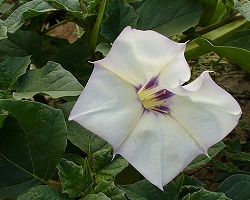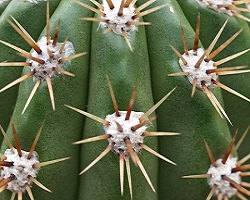Dry Plants

The desert is a difficult place to be a plant because of the dry, hot air. To move nutrients up their roots, plants evaporate water from their leaves in a process called transpiration. But in the desert, where water is hard to come by, many plants have adaptations to help save water. The plants can save water a few different ways: they can control the amount of water lost by transpiration, the amount they can get, or the amount they can store. If a plant has adaptations to help them deal with desert weather, we call them xerophytes, a word that means dry plants.
Dealing with the Desert

Cactus and other plants that store lots of water to help them through the dry seasons are called succulents. During even light rains, these plants soak up as much water as they can hold, storing the water in large storage areas in roots, leaves, or plant stems.
Some plants only live and grow during the wet season, producing seeds that can tolerate the dry season. These plants are called annuals, because they reappear every year. Thus the adult plant, which loses more water than the seed, avoids the hot and dry conditions of the dry seasons.
Other plants called perennials live for several years, but may go dormant or inactive during the dry season.

A lot of desert plants don’t store a bunch of water or die or become inactive during the dry season. Instead, these plants are able to tolerate or withstand the hottest and driest parts of the year.
A few different tricks help these plants handle the desert conditions. The sharp spines that you see on cactus and some other plants help shade the plant from the sun, keeping it cool. Certain plants like mesquite trees grow very long tap roots, reaching down over 100 feet to reach the groundwater, water stored deep underground.
The Fight for Water

For some plants, one way to make sure to get enough water is to get rid of the competition—that is, nearby plants. A plant called creosote makes special chemicals, or toxins, that they release into nearby soil. These toxins make it difficult for other plants to grow in that soil. This trick is called allelopathy, and it keeps away plants that would use up the creosote’s water supply.
Images via Wikimedia commons. Additional image by Duff Axsom.
Read more about: Delving into Deserts
Bibliographic details:
- Article: Plants of the Desert
- Author(s): Dr. Biology
- Publisher: Arizona State University School of Life Sciences Ask A Biologist
- Site name: ASU - Ask A Biologist
- Date published:
- Date accessed:
- Link: https://askabiologist.asu.edu/plants-desert
APA Style
Dr. Biology. (). Plants of the Desert. ASU - Ask A Biologist. Retrieved from https://askabiologist.asu.edu/plants-desert
Chicago Manual of Style
Dr. Biology. "Plants of the Desert". ASU - Ask A Biologist. . https://askabiologist.asu.edu/plants-desert
Dr. Biology. "Plants of the Desert". ASU - Ask A Biologist. . ASU - Ask A Biologist, Web. https://askabiologist.asu.edu/plants-desert
MLA 2017 Style

Desert plants come in all types, shapes, and sizes, like this succulent that is called the spiral aloe plant.
Be Part of
Ask A Biologist
By volunteering, or simply sending us feedback on the site. Scientists, teachers, writers, illustrators, and translators are all important to the program. If you are interested in helping with the website we have a Volunteers page to get the process started.

